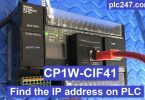In 1888, Nikola Tesla invented the first 3-phase AC induction motor, a few decades later the inverter was born to solve the problem of controlling the speed of alternating current motor.
Why do I say that the problem, that’s because when tesla creates 3-phase AC induction motors of course it is better and more reliable than Edison 1-D motors but controlling the engine speed alternating current required or changing magnetic flux or changing the number of poles on the motor.
Even when the induction motor is widely used, changing the frequency to control the speed is still an extremely difficult task and the physical structure of the motor prevents manufacturers from making Engine with more than 2 speed levels.
So what is the inverter? its structure and operation principle can control the speed of 3-phase AC induction motor. “plc247.com” will help you find out more details about inverters.
What is inverter?

An inverter is a device that converts alternating current at one frequency into an alternating current at another frequency that is adjustable.
The inverter is a device that changes the frequency of current applied to the motor’s internal winding and thereby can control the engine speed steplessly, without the need for mechanical gearboxes. The inverter uses semiconductor components to sequentially shut down the current applied to the motor windings to generate a rotating magnetic field that drives the motor.
Structure of the inverter

Main components inside the inverter include:
+ Rectifier Circuit: converts AC into DC, using semiconductor parts known as Diot.
+ Flattening capacitors: Works to flatten the DC voltage that has been converted through the rectifier circuit.
+ Reverse Circuit : Used to output AC voltage from DC voltage. The device called this inverter is different from the name and function rectifier. Used to supply variable voltage / frequency to the motor. Use IGBT(Insulated Gate Bipolar Transistor) and similar components that can be turned on and off.
+ Braking resistor: The excess electricity generated needs to be somehow managed. Resistors are used to quickly “burn off” this excess electricity generated by this phenomenon by converting the excess electricity into heat.
+ Control circuit: Controlling control, installing inverter.
The operating principle of the inverter

Operation principle of the inverter is also quite simple, mainly through 2 stages:
+ First, the single-phase or three-phase power source is rectified and filtered into a flat DC. This stage is done by diode bridge rectifier and capacitor. The input power can be single phase or 3 phase, but it will be at fixed voltage and frequency.
+ The dc voltage above will be transformed (inverted) into a symmetrical 3-phase AC voltage. Initially, the dc voltage generated will be stored in the capacitor array. This DC voltage is very high.
Next, through the proper self-activation process, the IGBT converter acts like an extremely fast on and off switch to create the output waveform of the inverter that will generate a three-phase alternating voltage PWM pulse width modulation method
Thanks to the advancement of microprocessor technology and current semiconductor technology, the frequency of switching pulses can be up to the ultrasonic frequency range to reduce engine noise and reduce losses on the motor iron core.
Classification of variables
+ AC inverter: the most widely used, designed to control AC motor speed
With different voltage levels:100VAC/220VAC/380VAC…
+ DC inverter: control the bypass of DC motor.
In addition, people also classify the inverter according to the capacity to meet the load, the special application of the inverter such as elevators, solar energy, crane …
Advantages of the inverter
- The drive can control stepless speed of electric motor.
- Drive efficiency is 98% higher
- The inverter speed control system is very simple, works in many different environments, is suitable for many different applications and can change the working speed of many motors at the same time as tape. conveyor, conveyor belts, tractors in textile industry …
- Smooth acceleration, anti-shock helps reduce the pressure on mechanical systems such as gear boxes, bearings, rollers…
- The inverter has a start-up mode with maximum torque for the conveyor belt, detecting belt breakage by monitoring the torque load.
- Power savings of up to 60% during startup and operation
- Easy to connect with automatic control system
- Fully integrated functions of overload protection, over temperature, over current, over voltage, low voltage, phase loss error, phase shift …
- Safe, convenient and low maintenance costs, maintenance








